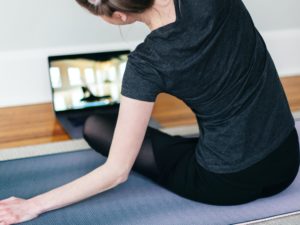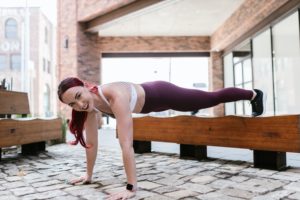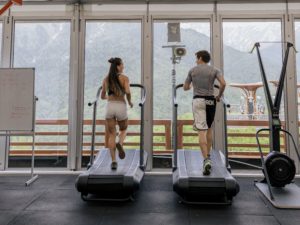How to Start Running – Tips, & Techniques for Form, Schedule, & More
How you run affects how far and fast you go. Therefore, if you want to start running as a hobby, knowing the best way to improve performance and reduce pain is important. This guide will provide the best running tips and techniques to help improve your running, reduce chances of injury, and decrease the impact on your joints while increasing your stamina, distance, speed, and more!

You may be training for a marathon, starting a daily exercise habit, or looking to work cardio into your weekly workouts. Whatever the case, it is crucial to learn how to run in the
Best Form for Running
There are different forms depending on your body mechanics and style. A certain technique may work for one person and not the other. The most important thing is to listen to the body, try the tips out, and see if they work. These tips are meant to decrease the chances of injury, increase speed, and boost stamina.
While Jogging
Jogging is a great way to conserve energy while keeping good speed during your run. When you are jogging, you are going to want to maintain good posture, shoulders back, head forward. Make sure your elbows stay close to the body, keep the hands loose, and use a relaxed swing that doesn’t cross the arms in front of the body.
Avoid hitting the ground with your heel. Instead, aim to hit the ground with the center of your foot in a midfoot strike. Heel strikes tend to be harsh on the knees and cause you to slow down.
While Sprinting
Sprinting is all about speed and intensity. It requires a full body activation that requires a lot of energy. While you sprint, lean forward slightly and engage your core. This can boost speed significantly. Short, fast strides tend to conserve energy. Keep posture good, with your shoulders back, and gaze forward.
Land softly, minimize impact with the ground, and use a forefoot strike. Bend the elbows and keep them close to the body. You can raise your hands as high as your chin, then back down to your lower back, but make sure you keep them from crossing in front of you.
While on a Treadmill
Treadmills are great options for those with access to one as they allow you to run on a smooth surface, controlling incline, keeping speed constant, and working on stamina easily. Plus, you don’t have to worry about running out of energy on your run back to your starting point.
Keep posture straight with spine erect, shoulders down. Use a short stride, as the treadmill will not allow for long strides. Try not to use the handrails, unless you need them for balance.
General Form Tips
Here are some mostly universal tips that can help you run at your best.
- Engage your core – plus, work on strengthening your core with experiences like planks or glute bridges.
- Avoid heel strikes – heel strikes put too much stress on the knees.
- Posture – keep good posture, with your spine straight, gaze forward, and shoulders back.
- Breathe – breathing fuels the body with energy. Keep deep breaths when you run. You can even try to align your breathing to your pace.
- Elbows in – keep your elbow tucked close to the body, bent at a 90-degree angle. Swing the arms naturally
- Lean – a slight lean forward can help you speed up.
10 Tips for Beginners Who Want to Start Running
Here are the top 10 tips for anyone, especially beginners, for when you start running!
1. Invest in Good Shoes
Running shoes are essential for a good run. Running in the wrong shoes can increase your chances of injury and may strain the body. In fact, the way your foot lands and rolls through all affects which running shoes you should get, so make sure you ask for excerpt advice at a running shoe store.
2. Pace Yourself
Keep your run to a soft, easy pace when you’re first starting out. The worst thing you can do is go too fast too quickly, then injure yourself or burn out. The body needs time to get used to running, how it moves, stresses, and strains the body.
3. Aim for Distance
Focusing on speed will potentially cause you to overwork yourself, especially at the beginning of your run journey. Aim for a certain distance without worrying about the pace when you are first starting out. As you continue, your pace, stamina, and endurance will naturally become faster and stronger.
4. Track Yourself
You can track your runs with something as simple as a watch to make sure you are pushing yourself just a little bit more each run day. A watch can be used to time yourself and can help you with alternatives between 1-minute jogs and 1-minute runs. Another way to track is to monitor your distance and build up your distance goals as you progress as a runner.
5. Build Up Gradually
Break down your runs into a mix of walking, jogging, and running. Again, the body is learning to move a certain way. Endurance and speed and things that come with time, so switch up your form to activate muscles and give yourself rest during your run.
6. Join a Club
Joining a runner club can make a solitary experience more social. It can help you gain tips and insight from people who have been running for longer and can motivate you to stick to your goals.
7. Mix Up Route
Mixing up the route and surfaces you run on is a good way to become a well-rounded runner. Smooth surfaces like sidewalks and pavement are good for speed, but running on the ground or on a hill trains different muscles. A softer ground decreases the impact on the joint, but due to the uneven surface, you are also more likely to roll an ankle. Go slow, switch up routes, and train for all terrains.
8. Walk it Off
If you need to walk during a run, walk. There is no failure in walking. Walking is, in fact, a really good exercise in general. It is low impact, meaning you won’t stress the joints, and it gives you a chance to recover.
9. Stretch After Running
The muscles after a run need to be stretched for a couple of reasons. Stretching in and of itself can help develop muscle strength and flexibility needed to run. It is important to stretch with the muscles warmed up like they are after a run. Think of muscles like cheese. If you pull them cold, they may tear. If you warm them up, you can stretch them with more ease and less chance of injury. Stretching after a run may also help ease soreness the next day!
10. Rest days
Your body needs time to recover, especially when you are first starting out. Your body needs time to develop new muscles, reinforce joints, and prepare for your future runs. The schedule below details a way to train for a distance goal, but when first starting out, prioritize rest. In fact, it may be beneficial to take a rest day in between run days!
Start Running – Schedule to Follow
Here is a simple routine to help you start running. It’s perfect for someone who’s a beginner and wants some structure! Remember though, the hardest part of running is starting, so you don’t need to necessarily follow any specific schedule or routine.
- Monday – Walk or jog a short distance goal.
- Tuesday – alternate between 2 minutes jogging and 1 minute walking to a distance goal.
- Wednesday – leg day workout. Do sets of lunges and squats. Add weight if needed.
- Thursday – alternative between jogging as much as possible and walking.
- Friday – Walk to your short-distance goal.
- Saturday – alternative between jogging as much as possible and walking to your goal.
- Sunday – Rest day.
An alternative to this simple routine would be taking a rest day in between each run/jog. For example, if your goal is 2 miles, run this on Monday, take a rest day on Tuesday, and do it again on Wednesday, and so forth. Make sure you are listening to your body. If you need to, an alternative between running and active rest days. On these rest days, you can do yoga, walking, swimming, or any other soft activity.
The Takeaway
Running can seem intimidating to someone who has no experience, but when you check out these techniques, it becomes more accessible. If you want to start running, you should definitely follow some of the tips, such as pacing yourself, going for distance, and investing in a good pair of running shoes.
Remember that health starts from within, so eat nutrient-dense food, exercise when you can, and take care of your mental wellbeing. Try to take care of gut health as well! The microbiota affects the entire body, from your metabolism, muscles, and immune system, to digestion, and more! Get all the resources you need about microbiota health for free here!





